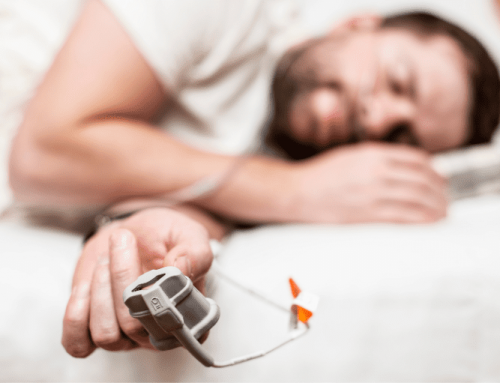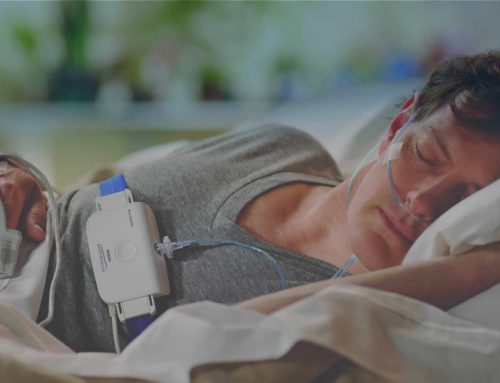
What Does it Mean When Cardiac Arrhythmias Happen While Sleeping
The heart’s sole purpose is to steadily contract in order to circulate blood and nutrients to every living cell throughout the body. The heart is made up of four chambers, two atria, and two ventricles. For the heart to beat, an impulse must start in the SA node, located at the top of the right atrium. The SA node initiates an electrical impulse that travels down the walls of the atria. This causes a contraction forcing blood into the ventricles. Next, the AV node, which is located at the center of the heart, slows the electrical impulse to allow the atria to fully contract and completely empty all the blood into the ventricle. Once the ventricles are filled with blood, the His-Purkinje Network sends the electrical impulse through the ventricles’ walls, causing them to contract and force blood out of the heart and throughout the rest of the body. When this process gets interrupted, the heart either pumps too fast, too slow, or in an irregular pattern, interfering with the heart’s ability to pump blood effectively. This is referred to as a cardiac arrhythmia. Most of the time, heart arrhythmias are harmless. However, if the heartbeat is highly irregular, an arrhythmia can cause severe complications and may become life-threatening. While cardiac arrhythmias can occur in healthy individuals, certain conditions can contribute to, or cause, an arrhythmia, including scarring of the heart tissue, heart attack, coronary artery disease, high blood pressure, or electrolyte imbalances. Additionally, cardiac arrhythmias can occur while sleeping and can be triggered by sleep-disordered breathing like sleep apnea.
Obstructive sleep apnea is the most common type of sleep-disordered breathing. Sleep apnea is a condition in which the muscles in the back of the throat and tongue relax, obstructing airflow to the lungs, causing frequent wakings due to the inability to supply an adequate amount of oxygen to vital organs. These episodes can occur several times an hour and typically last for 10 seconds or longer. Nearly 22 million Americans are affected by sleep apnea, although close to 80% of these cases are undiagnosed. Without proper diagnosis and treatment of obstructive sleep apnea, the risk of cardiac complications, such as high blood pressure, heart attack, and stroke, increase. In fact, the prevalence of sleep apnea is two to three times higher in patients with cardiovascular disease than in the general population.
Obstructive sleep apnea is one of the most common causes of cardiac arrhythmias during sleep. Studies have shown a significant association between sleep apnea and atrial fibrillation, the most common type of cardiac arrhythmia. About half of patients diagnosed with atrial fibrillation also have obstructive sleep apnea, and those diagnosed with sleep apnea are two to four times more likely to develop atrial fibrillation. This is most likely due to sleep apnea’s association with high blood pressure. Obstructive sleep apnea and atrial fibrillation typically occur together in individuals due to their shared risk factors, including obesity, autonomic imbalances, and heart enlargement. When apnea episodes occur, it causes the heart rate to drop. When the brain detects inadequate amounts of oxygen, it alerts the body to wake up with a snore or choke, and heart rate accelerates, causing blood pressure to rise. An event such as this can trigger an arrhythmia. Complications from repeated episodes of sleep apnea include lower oxygen levels in the blood, increased carbon dioxide levels and inflammation markers, and pressure changes in the chest. Consequently, over time this can lead to heart conditions such as high blood pressure, thickening of the heart muscle, and stiffening of the heart. These complications compromise the heart’s ability to function correctly, leading to cardiac arrhythmias, especially atrial fibrillation.
Treating both conditions in conjunction with one other is crucial for resolving symptoms and reducing the recurrence of either condition. For instance, untreated sleep apnea impairs the ability to control atrial fibrillation because it reduces the effectiveness of certain medications that control heart rate and treatments like cardioversion or catheter ablation. Typically, sleep apnea is treated with a CPAP. This machine helps control the patient’s breathing by continuously blowing air through a mask to keep the throat open to allow normal breathing. This can improve atrial fibrillation by 42%, increasing the effectiveness of treatments and resulting in better overall health.
Patients diagnosed with atrial fibrillation, or other types of cardiac arrhythmias should be assessed for symptoms and specific risk factors that could indicate possible obstructive sleep apnea. These risk factors include excess weight or obesity, narrowed airway, chronic nasal congestion, high blood pressure, smoking, alcohol use, over the age of 40, gender (male), and family history of sleep apnea. If multiple risk factors are found, and you or your spouse notice recognizable symptoms of sleep apnea like morning headache, loud snoring, excessive sleepiness, or frequent night wakings, additional testing should be done for a proper diagnosis. Sleep apnea is diagnosed with either an at-home sleep test or an in-lab sleep study. Vitalistics offers an easy and convenient diagnostic test that can be completed from the comfort of your own home. A small tube is placed under the nose, and a belt is worn around the chest to measure breathing or any pauses in breathing. A sensor is placed on a finger that measures the oxygen content of the blood and heart rhythm. The device will continuously record data throughout the night as you sleep. The data is downloaded and reviewed by one of our clinical specialists, then given to your physician to discuss with you. Home sleep testing with Vitalistics is convenient, easy, and quick in getting answers to your sleep problems. We are here to help you achieve the healthiest sleep and life possible.






